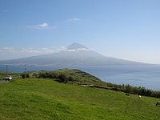
Mount Pico
Encyclopedia
Mount Pico is a stratovolcano
and the highest point on Pico Island
in the Azores
. It reaches an altitude of 2,351 meters (7,713 ft) above sea level, which makes it the highest point in Portugal and also in the Mid-Atlantic Ridge
. Pico is more than twice the elevation of any other peak in the Azores.
Pico Alto the round crater
about 500 meters (1,600 ft) in diameter and 30 meters deep tops the volcano, with Piquinho (Pico Pequeno) a small volcanic cone
rising 70 meters within it to form the true summit. Historical eruptions of Pico have occurred from vents on its flanks rather than the summit crater. In 1562–64, an eruption on the southeast flank produced lava flows which reached the sea. Another flank eruption in 1718 also produced flows which reached the coast. The most recent eruption occurred in December 1720.
Hiking trails are available and the ascent to the summit can be made in around two to four hours from the trailhead for fit persons depending on weather which can be quite treacherous especially in winter months.
Stratovolcano
A stratovolcano, also known as a composite volcano, is a tall, conical volcano built up by many layers of hardened lava, tephra, pumice, and volcanic ash. Unlike shield volcanoes, stratovolcanoes are characterized by a steep profile and periodic, explosive eruptions...
and the highest point on Pico Island
Pico Island
Pico Island , is an island in the Central Group of the Portuguese Azores noted for its eponymous volcano, Ponta do Pico, which is the highest mountain in Portugal, the Azores, and the highest elevation of the Mid-Atlantic Ridge...
in the Azores
Azores
The Archipelago of the Azores is composed of nine volcanic islands situated in the middle of the North Atlantic Ocean, and is located about west from Lisbon and about east from the east coast of North America. The islands, and their economic exclusion zone, form the Autonomous Region of the...
. It reaches an altitude of 2,351 meters (7,713 ft) above sea level, which makes it the highest point in Portugal and also in the Mid-Atlantic Ridge
Mid-Atlantic Ridge
The Mid-Atlantic Ridge is a mid-ocean ridge, a divergent tectonic plate boundary located along the floor of the Atlantic Ocean, and part of the longest mountain range in the world. It separates the Eurasian Plate and North American Plate in the North Atlantic, and the African Plate from the South...
. Pico is more than twice the elevation of any other peak in the Azores.
Pico Alto the round crater
Volcanic crater
A volcanic crater is a circular depression in the ground caused by volcanic activity. It is typically a basin, circular in form within which occurs a vent from which magma erupts as gases, lava, and ejecta. A crater can be of large dimensions, and sometimes of great depth...
about 500 meters (1,600 ft) in diameter and 30 meters deep tops the volcano, with Piquinho (Pico Pequeno) a small volcanic cone
Volcanic cone
Volcanic cones are among the simplest volcanic formations. They are built by ejecta from a volcanic vent, piling up around the vent in the shape of a cone with a central crater. Volcanic cones are of different types, depending upon the nature and size of the fragments ejected during the eruption...
rising 70 meters within it to form the true summit. Historical eruptions of Pico have occurred from vents on its flanks rather than the summit crater. In 1562–64, an eruption on the southeast flank produced lava flows which reached the sea. Another flank eruption in 1718 also produced flows which reached the coast. The most recent eruption occurred in December 1720.
Hiking trails are available and the ascent to the summit can be made in around two to four hours from the trailhead for fit persons depending on weather which can be quite treacherous especially in winter months.

